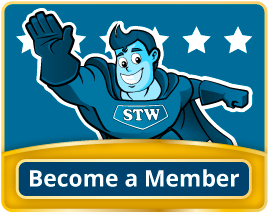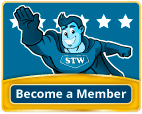4th Grade Common Core: RI.4.1
Common Core Identifier: RI.4.1 / Grade: 4
Curriculum: Reading Informational: Key Ideas and Details
Detail: Refer to details and examples in a text when explaining what the text says explicitly and when drawing inferences from the text.
153 Common Core State Standards (CCSS) aligned worksheets found:
Find out about three different subgroups of arthropods- insects, arachnids, and myriapods.
Level:
Filing Cabinet
Logged in members can use the Super Teacher Worksheets filing cabinet to save their favorite worksheets.
Quickly access your most used files AND your custom generated worksheets!
Please login to your account or become a member and join our community today to utilize this helpful feature.
An amazing article about your brain, plus a series of seven reading comprehension questions to go with the article.
Level:
Students will enjoy reading about bats, skunks, owls, and other nocturnal animals.
Level:
Answer the question on this worksheet. Questions include: "Can a dolphin drown? Explain." and "Is a bat a mammal or a bird? Explain."
Level:
This non-fiction article about owls describes how they're adapted for nighttime hunting. Includes a page of reading comprehension questions, a vocabulary activity, and a writing prompt.
Level:
An article about the history of the Jack o' Lantern. Includes comprehension and vocabulary questions.
(Approx. Grade Levels: 3-5)
(Approx. Grade Levels: 3-5)
Level:
Learn about the anatomy and behaviors of one of the most feared spiders in the world.
Level:
Discover why Benjamin Franklin thought the wild turkey would be the ideal bird to symbolize America. Approximately 4th grade reading level.
(Approx. Grade Levels: 4-5)
(Approx. Grade Levels: 4-5)
Level:
Even though they are sometimes called earth pigs, aardvarks aren't really related to pigs at all.
Level:
Learn about a monarch butterfly's metamorphosis as it transforms from a caterpillar into a butterfly.
(Approx. Grade Level: 3-4)
(Approx. Grade Level: 3-4)
Level:
Learn about the gas giants that can be found beyond the asteroid belt.
Level:
Read about the differences between carnivores, omnivores, and herbivores.
Level:
The hammerhead shark is one of the fiercest and most dangerous animals in the sea. It uses electroreceptors in its unusual-shaped head to find prey.
Level:
This short biography of Walt Disney is filled with interesting facts. Students read the biography and test their comprehension with the questions that follow.
Level:
Have you ever heard of a barking deer? If you visit South Asia you may see muntjacs - small deer that bark like dogs.
Level:
Learn how walnuts grow, and why they're important to people.
Level:
Fennec Fox FREE
The bushy-tailed, big-eared fennec fox in an amazing species that is adapted to live in desert climates.
Level:
Learn how alligators and crocodiles are different and how they're similar.
Level:
Discover everything you wanted to know about spiny hedgehogs.
Level:
Discover how jaguars live and hunt, and learn why these beautiful animals are endangered.
Level:
Are dragons real? You bet they are. Indonesians know all about the fierce lizard known as the Komodo dragon.
Level:
Are grasshoppers a farmer's friend or foe? Actually, both. Find out how grasshoppers can help and harm humans.
Level:
Learn how dolphins and porpoises are alike, and how they're different. This article includes a question page, a Venn diagram, and a vocabulary activity.
Level:
The wolverine is a solitary, but fierce, hunter who lives in snowy, northern climates across the world.
Level:
This nonfiction article describes the many unknown virtues of dandelions.
Level:
Read about the lucky turkeys that have been pardoned by American presidents throughout history.
(Approx. Grade Levels: 4-5)
(Approx. Grade Levels: 4-5)
Level:
Earthworms have no eyes, no nose, no ears, no bones, no arms, and no legs. They do, however, have very complex bodies.
Level:
Learn about the three layers of the skin, and find out how skin keeps our bodies safe and healthy.
Level:
These unusual animals spend most of their lives at sea, but occasionally climb onto Pacific beaches for a period of rest and molting.
Level:
This strange looking animal has four legs, a long snout, large ears,and lurks in the forests of Central and South America.
Level:
In Hawaii, Santa arrives in an outrigger canoe, or sometimes he even catches a wave and surfs into the islands. Learn about this, and other unique Hawaiian Christmas traditions.
(Approx. Grade Level: 4-6)
(Approx. Grade Level: 4-6)
Level:
Discover the similarities and differences between frogs and toads.
Level:
It's not a bird, nor a plane. It's a flying fish! Learn all about these strange animals.
Level:
Bee Hummingbird FREE
The world's smallest bird - the bee hummingbird - can hover in place, fly upside down, and even fly backwards.
Level:
When President Theodore Roosevelt wouldn't shoot a bear on a hunting trip, he became known as a kind and humane person. The toy that was named after him reminds us of his legacy.
Level:
Discover the stink bug - an animal that uses a noxious odor to scare enemies away.
Level:
I bet you didn't know that an octopus can vanish in a cloud of smoke. It's just one of the unique ways an octopus can defend itself.
Level:
Learn about the events that cause winter, how animals prepare for winter, and wintertime activities people enjoy.
Level:
Can your students tell a reptile from an amphibian? This compare and contrast article will help students learn the differences between these two vertebrate groups.
Level:
An article about the history of trick-or-treat. Includes questions.
(Approx. Grade Levels: 3-5)
(Approx. Grade Levels: 3-5)
Level:
Bighorn Sheep have horns that weigh up to 30 pounds. Males will battle by ramming each other in the head.
Level:
Bears don't wear glasses, but the spectacled bear from South America has circular markings that make it look like it's got spectacles.
Level:
This article teaches students the legends and history behind three symbols of St. Patrick's Day - shamrock, the Blarney Stone, and leprechauns. This article is written at approximately a 5th grade reading level.
Level:
A porcupine rattles its quills and sends off an unpleasant odor to protect itself. Finding yourself on the wrong end of a porcupine's quills may be more thrills than you're looking for.
Level:
The article explains how constellations got their names (comparing it to finding pictures in the clouds) and how the same constellation can be known by different names across the globe.
Level:
Comparing two texts - an article and a poem; Learn about Venus Flytraps and answer the questions.
Level:
The flamingo is one of the most recognized birds in the world because of it's unusual body shape and hot-pink feathers.
Level:
In 1953, two climbers, Edmund P. Hillary and Tenzig Norgay, became the first men to climb to the summit of Mount Everest.
Level:
The secretary bird is a large, terrestrial raptor from Africa. It eats mice, hares, mongooses, lizards, and even snakes.
Level:
Learn the similarities and differences between butterflies and moths.
Level:
Some desert plants are adapted to thrive in dry and hot climates.
Level:
Hibernation is when animals slow down for the winter and fall into a sleep-like state. Learn about animal hibernation with this interesting article.
Level:
A short biographical overview of Gertrude Ederle, the first woman to swim across the English Channel.
Level:
Learn how a tree makes its food (glucose) through a process called photosynthesis.
Level:
This passage features an overview of George Washington's life.
Level:
Read about the three different types of wetlands: swamps, bogs, and marshes.
Level:
This informative article compares and contrasts Thanksgiving in the United States to Thanksgiving in Canada. Approximately 3rd grade reading level.
(Approx. Grade Levels: 3-5)
(Approx. Grade Levels: 3-5)
Level:
An Atom Apart FREE
A scientific article about atoms, the building blocks for molecules and everything that's made of matter
Level:
From ancient cave discoveries to Aztec ceremonies to playing a part in the invention of the microwave, popcorn has a fascinating history.
Level:
Learn all about roly-poly pill bugs, which curl up in a ball to protect themselves.
Level:
Students will enjoy this cute poem about the unusual names that trees are given.
Level:
The cutest mammals in Australia actually have very sharp claws and they spend more time asleep than they do awake.
Level:
The honey badger is arguably the most fearless animal on Earth. It eats porcupines and venomous snakes, raids beehives for honey, kidnaps baby cheetahs, and steals food from hungry lions.
Level:
Learn the similarities and differences between boas and pythons with this compare/contrast article.
Level:
Dr. Seuss Biography FREE
Read all about the life and works of Theodore Seuss Geisel. This passage was written at a 3rd or 4th grade reading level. There is also a page of reading comprehension questions to answer at the end of the passage.
Level:
Here is a nonfiction passage about the desert cottontail, an interesting animal that lives in the American southwest.
Level:
Students read a short nonfiction paragraph about cheetahs and answer the questions that follow.
Level:
Chameleons can change color, rotate their eyes, and have toes that are specially adapted for climbing.
Level:
This biographical article highlights the major events of Abraham Lincoln's life.
Level:
Perhaps the most well-known structure in all of France, the Eiffel Tower is easily recognizable to most. However, there's a lot to know about the tower that you might not expect. Read this article and answer the questions that follow to find out all about the world-famous building.
Level:
This nonfiction article tells how elephants played important roles in both World Wars. Students will carefully read the article and complete questions, a vocabulary activity, and a reading prompt to test their reading comprehension.
Level:
Crater Lake National Park is located in Oregon, in the United States. Crater Lake is a deep blue lake sitting within a crater. It is the deepest lake in the USA.
Level:
Learn about a special kind of wetland found mostly along the Gulf of Mexico by reading this article. Complete a paired crossword, writing prompt, and variety of comprehension questions.
Level:
Kids will learn lots of fun facts with this engaging insect scavenger hunt. Just hide the 18 cards around the room and have them search for each one. They'll answer a question on their worksheet about each card they find.
Level:
Yellowstone was the first national park in the United States. It is home to Old Faithful, a geyser that regularly erupts with a spray of water and steam.
Level:
The Middle East is known for its dry and arid climate, so how did it end up as home to some of the earliest known farming and the first civilizations? Read this article to find out!
Level:
This short passage offers a great overview or introduction to lines of latitude and longitude.
Level:
The Erie Canal is an important waterway in New York State. Built between 1817 and 1825, it impacted the economy of both the state and the country as a whole. Reading comprehension questions, a vocabulary exercise, and a writing prompt follow the article.
Level:
Learn the history behind the rallying cry used in both the Texas Revolution and Mexican-American War. File comes complete with a territory map, six questions, vocabulary crossword, and creative writing prompt.
Level:
Read about Bessie Coleman, the first African American woman to become a pilot, with this printable worksheet.
Level:
Read about Mount St. Helens and its famous volcanic eruption. Then answer reading comprehension questions about the article.
Level:
Learn all about whale sharks - the world's largest fish! This reading comprehension activity includes questions about the text, vocabulary words, and a writing prompt. An answer key is included.
Level:
Japan's world-famous Mt. Fuji is one of the most photographed natural landmarks on Earth. Learn about it in these two paragraphs.
Level:
Did you know Pompeii wasn't the hardest-hit city when Mt. Vesuvius erupted in 79 C.E.? Read to learn more about this famous volcano.
Level:
Did you know that stingrays are in a group of fish called batoids because their bodies look like bats gliding through the water? Learn this and other interesting facts about stingrays in this reading comprehension activity!
Level:
Hide these cards around the classroom and have your students complete this engaging and educational scavenger hunt activity about the American Revolutionary War.
Level:
Read this short article about Wilma Rudolph, an Olympian who overcame immense odds and broke three world records in track and field.
Level:
This article includes lots of facts about the amazing saguaro cactus of the Sonoran Desert. Test students' reading comprehension skills by having them answer the questions after reading the article.
Level:
Pseudoscorpions are tiny, harmless scorpion-like creatures that can sometimes be found in bathrooms. Read about these interesting arachnids and answer the questions.
Level:
This reading comprehension passage gives an overview of several hero and monster stories from Greek mythology. The worksheet includes reading comprehension questions, a vocabulary activity, and a writing prompt.
Level:
Read all about the gibbon, a type of agile ape, and answer questions about the article. The worksheet includes a vocabulary crossword and a writing prompt.
Level:
What is that fuzzy green stuff growing on the sandwich you left out for too long? It's mold! Learn all about what mold is, how it forms, and how mold is both harmful and helpful in this fascinating article. Worksheet includes comprehension questions, a writing prompt, and vocabulary terms.
Level:
Puerto Rico's unofficial version of a national animal is the coqui. This tiny frog happens to be the loudest amphibian in the world! Learn all about it in this 2-page article.
Level:
This article tells the unique history of Haudenosaunee beadwork, seen on items such as pincushions, purses, and picture frames. After reading the passage, students will test their understanding by answering several reading comprehension questions and completing a vocabulary activity and writing prompt.
Level:
Your students will learn about how the first settlers in America established their colonies and the hardships they faced.
Level:
Learn about the famous composer and musician Ludwig van Beethoven with this engaging article and worksheet. After reading the article, students will answer reading comprehension questions, respond to a writing prompt, and complete a vocabulary activity.
Level:
Cut out and hide these cards all over the classroom. Then have students look for them and answer the questions on the attached worksheet. It's an engaging way to get students learning about the history and culture of ancient Rome.
Level:
Glacier National Park covers over a million acres of Montana. It is home to grizzly bears, moose, wolverines and lynxes.
Level:
Hide these scavenger hunt cards around the classroom for a fun and educational activity about American history. Students will read each of the cards as they find them and answer the corresponding questions.
Level:
Insects have no backbones, three main body parts, and six legs. These three paragraphs and paired questions explore what makes an insect an insect.
Level:
The Lewis and Clark Expedition was an exploration of U.S. land from the Mississippi River to the Pacific Ocean.
Level:
This reading comprehension article and worksheet gives a great overview on the concept of erosion.
Level:
Learn about the reason why leaves change their color in the fall! This worksheet includes reading comprehension questions, a writing prompt, and vocabulary terms. An answer key is included.
Level:
Did you know koi are a kind of carp? Koi come in a variety of colors, patterns, and fin shapes. They're lovely to look at, but their price and life spans might surprise you!
Level:
Learn all about these fascinating canines with this engaging reading comprehension passage. After the article, there are several questions, a crossword with key terms, and a writing prompt.
Level:
Learn all about the sleep cycle, dreaming, and more in this fascinating nonfiction article!
Level:
Read about the Newfoundland pony, an animal known for its strength, courage, and common sense. Then answer a series of reading comprehension questions, complete a vocabulary activity, and respond to a writing prompt.
Level:
The Grand Canyon is known for its enormous size and colorful landscape. It also reveals some of the most ancient rock layers in all of North America.
Level:
Learn more about the Age of Exploration and the explorers who were part of it with this fun scavenger hunt activity.
Level:
Hide these cards around the room and have students search for them. When they find and read each card, they should be able to answer all of the questions on the worksheet.
Level:
In 1803, the President Thomas Jefferson bought the Louisiana Territory from France. This doubled the size of the United States.
Level:
Jump-start students' critical thinking about matter with this worksheet. Questions ask students to think deeply and consider concepts like how we can observe gases without seeing them, why sand can be poured if it's not a liquid, and more.
Level:
Read about Mary Anning, a woman known to be one of the greatest fossil hunters of all time, in this short article.
Level:
Students will read this informative article about spider monkeys--the acrobats of the rain forest! Then they'll answer questions, including a vocabulary activity and writing prompt.
Level:
Did you know that rabbits and hares are actually different? Learn the similarities and differences between rabbits and hares in this reading comprehension article. Comprehension questions, a writing prompt, and vocabulary words are included.
Level:
This interactive activity will teach your students lots of facts about women's history. They'll search for fact cards around the classroom and then answer the corresponding questions.
Level:
Students will learn lots of fun facts about ancient Mesopotamia with this engaging activity that gets learners out of their seats and moving.
Level:
This short reading passage includes interesting facts about the continent of Australia. Four reading comprehension questions accompany the article.
Level:
This engaging article will teach readers all about otters. Then, they'll complete reading comprehension questions that reinforce key ideas from the article.
Level:
Help students learn key facts about the Louisiana Purchase with this immersive scavenger hunt activity.
Level:
Read about Jane Goodall, a woman famous for her research on chimpanzees. Then answer several reading comprehension questions to test your understanding of the material.
Level:
Learn about the Pentagon with this reading comprehension passage. The worksheet includes a vocabulary exercise, short answer and multiple choice questions, and a writing prompt.
Level:
Did you know people have been chewing gum for thousands of years? Learn about the history of bubble gum in this fascinating article! Reading comprehension questions, writing prompt, and vocabulary words are included in this activity.
Level:
Elizabeth Blackwell was the first woman doctor in the United States. Read this short article to learn more about her life.
Level:
Read about the Colosseum, an iconic building in Rome, Italy, and answer questions about it. Questions include multiple choice, short answer, a vocabulary activity, and a writing prompt.
Level:
Learn what makes vertebrates and invertebrates different in this clever poem! Children will choose an animal to classify as a vertebrate or invertebrate in a writing activity, plus learn some new vocabulary words, and answer reading comprehension questions. An answer key is included.
Level:
The Appalachians are some of Earth’s oldest mountains. They run through several provinces and more than a dozen states. Find out how they were shaped and how they shaped communities in this article.
Level:
This nonfiction article and reading comprehension worksheet is a great resource for teaching your students about the Haudenosaunee Confederacy, sometimes called the Iroquois or Six Nations.
Level:
In 1932, aviation pioneer Amelia Earhart became the first female pilot to fly solo across the Atlantic.
Level:
The wide, flat plains of Tornado Alley are a recipe for one of Earth's strongest storms! Read about how, when, and where tornadoes tend to form in this full-length article.
Level:
Hide these cards around your classroom and have your students complete the scavenger hunt. Along the way, they'll answer questions about the information on the cards.
Level:
Niagara Falls is located between the United States and Canada. It is a popular tourist destination for visitors from around the world.
Level:
On this free printable, students count the symbols in each picture to determine if each material is positively charged or negatively charged.
Level:
Draw arrows to show the path of electricity in the series and parallel circuits.
Level:










